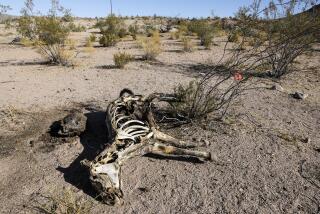Roadside seller has a few bones to pick : Then he dries them, bleaches them and prices them in a no-frills skeleton operation.
- Share via
VELARDE, N.M. — The sign works better than a speed trap. As the cars slow down, the flash of taillights is visible for miles on the flat, brown highway between Taos and Santa Fe. The sign says simply, “A Big Pile of Bones.”
Beneath those oddly beckoning words, wisps of long hair dangle like scalps from the barbed-wire fence, dancing in the wind coming down from the Sangre de Christo mountains. Up close they turn out to be horse tails. Hooves hang from aspen lodge poles alongside animal hides and big piles of bones.
Resting in the dust are mounds of jawbones, pelvic bones, ribs, femurs, tangled antlers. Hundreds of bleached white skulls--buffalo, cow, deer, elk, rabbit, rodent, cat, dog, goat, sheep--are mounted on ramshackle fences and stacked on rickety tables.
Inevitably, those who have jammed on their brakes, pulled off the highway and emerged from their vehicles stop and peer around before leaving the safety of the roadside.
In the midst of this carnage are dozens of sheep--live ones--including one giving birth. A rooster attacks a mangy dog. It’s a strange thing about dogs in this part of the country--they all look alike.
Near the rear of this weird place sits a bubbling black caldron, like a sinister prop from MacBeth. No witches, however. The man stirring the pot full of animal skulls and occasionally hauling one out to scrub off some gristle with a steel brush wears a stained baseball cap bearing the slogan “No. 1 Dad.”
Stanley Bulis, sheepherder and bone dealer extraordinaire, deals in dead stuff. Skulls mostly.
“I’ve always collected heads,” he explained one day not long ago. “I lost my first sheep when I was 9 and I kept her head, just to remember her by.”
Today, at his roadside attraction, Bulis sells 7,000 to 8,000 skulls a year. He gets them by the truckload from rendering houses, meat-packing plants, ranches and people who forage the countryside for road kills. Some of his suppliers have substance abuse problems, living from pint to pint or snort to snort. They bring in a head, looking for $20.
Bulis, a portly, bearded man of 54, recently had 600 of his sheep butchered for sale on the Muslim market in Los Angeles. A Muslim friend had come to Velarde to perform the appropriate religious ceremonies and then sold the meat. Of course, Bulis had the heads and other bones returned to him for his business.
Think of the place as a chop shop--for animal parts.
“A live rabbit is worth about $10,” said Bulis. “Dead it’s worth $30. I can get $6 for the hide, between $3 and $20 for the skull, $5 for the pelvis and $2 apiece for the shoulder blades. A quarter for each rib and backbone. Then I can eat the meat.”
Bulis considers himself an environmentalist. “We recycle everything,” he said. “I will sell my dog when he goes.”
The process is simple, sort of like making soup. Bulis boils the heads and bones to remove the meat. “I don’t use harsh chemicals because they cost money. Just plain water,” he explained, plucking a sample skull from the vat.
Heads cure in the sun for 30 days before they are put out for sale. That way they bleach naturally, and Bulis doesn’t waste money on chemicals, such as Clorox. He also grinds his own paste of bones and glue to fill bullet holes.
Some people have a fascination with dead stuff. And Bulis has developed a clear picture of his customers.
“Lawyers, doctors, morticians, dentists are good buyers,” he said. “I sell to a lot of designers, illustrators and architects, too. One guy told me he became an architect after studying a skull--how intricately it was put together, its stress points and how, although it has a lot of give, it won’t break.”
Who doesn’t buy? “People with bike racks on their cars never buy. I’ve never sold anything to a guy in a baseball cap or a carload of women with California plates or an animal activist.”
More to Read
Sign up for Essential California
The most important California stories and recommendations in your inbox every morning.
You may occasionally receive promotional content from the Los Angeles Times.













